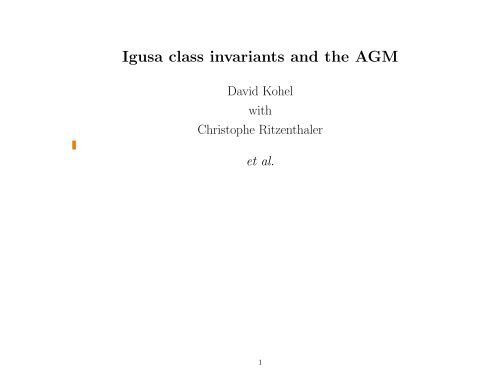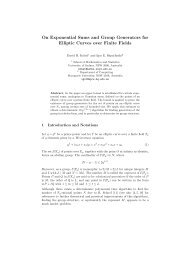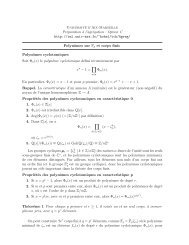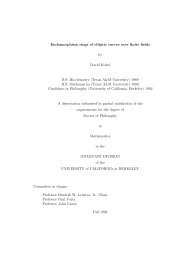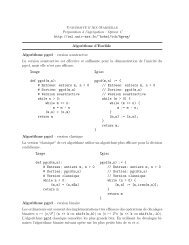Igusa class invariants and the AGM - ECHIDNA: Elliptic Curves and ...
Igusa class invariants and the AGM - ECHIDNA: Elliptic Curves and ...
Igusa class invariants and the AGM - ECHIDNA: Elliptic Curves and ...
Create successful ePaper yourself
Turn your PDF publications into a flip-book with our unique Google optimized e-Paper software.
<strong>Igusa</strong> <strong>class</strong> <strong>invariants</strong> <strong>and</strong> <strong>the</strong> <strong>AGM</strong>David KohelwithChristophe Ritzenthaleret al.1
Canonical Lifting <strong>and</strong> <strong>the</strong> <strong>AGM</strong>The <strong>AGM</strong> algorithm applies to any ordinary hyperelliptic curve C/kof genus 2, where k = F 2 r, which we may represent in Weierstrass form:C/k : y 2 + v(x)y = u(x)v(x)where v is squarefree of degree 3 <strong>and</strong> u is of degree at most 3.The Jacobian J of C, has four 2-torsion points over some extension field,generated by <strong>the</strong> three points (α i , 0) where v(α i ) = 0.Let K be <strong>the</strong> unramified extension of degree r over Q 2 . The <strong>AGM</strong>algorithm constructs a canonical lift — a principally polarized abeliansurface J /K which lifts <strong>the</strong> polarised Jacobian J/k, toge<strong>the</strong>r with itsring of endomorphisms: End K (J) ≃ End k (J ). We do so by recursivelysolving for a sequence of 2-adic numbers which converge to ‘<strong>invariants</strong>’associated to J = Jac(C).2
<strong>AGM</strong>: Initializing <strong>the</strong> CurveLift C over K: Lift v <strong>and</strong> u arbitrarily to V <strong>and</strong> U in K[x] <strong>and</strong> setC/K : Y 2 = (2y + V (x)) 2 = V (x)(V (x) + 4U(x)).Extend K, if necessary, so that V (x) has three distinct roots α 1 , α 2 , <strong>and</strong>α 3 . Then we can write in K,3∏3∏C/K : Y 2 = (x − α i ) (x − (α i + 4β i )).i=1i=1Initialise of 2-adic <strong>invariants</strong> of <strong>the</strong> curve:e 1 = α 1 , e 3 = α 2 , e 5 = α 3 ,e 2 = α 1 + 4β 1 , e 4 = α 2 + 4β 2 , e 6 = α 3 + 4β 33
<strong>AGM</strong>: Initialising <strong>the</strong> LiftThe Thomae formulas give us 4 initial <strong>invariants</strong>A = √ (e 1 − e 3 )(e 3 − e 5 )(e 5 − e 1 )(e 2 − e 4 )(e 4 − e 6 )(e 6 − e 2 )B = √ (e 1 − e 3 )(e 3 − e 6 )(e 6 − e 1 )(e 2 − e 4 )(e 4 − e 5 )(e 5 − e 2 )C = √ (e 1 − e 4 )(e 4 − e 5 )(e 5 − e 1 )(e 2 − e 3 )(e 3 − e 6 )(e 6 − e 2 )D = √ (e 1 − e 4 )(e 4 − e 6 )(e 6 − e 1 )(e 2 − e 3 )(e 3 − e 5 )(e 5 − e 2 )where <strong>the</strong> square root of an element of <strong>the</strong> form 1 + 8O K is taken as <strong>the</strong>unique element of Z q of <strong>the</strong> form 1 + 4O K .These numbers are 2-adic analogues of special values of <strong>the</strong> <strong>the</strong>ta functionsfor <strong>the</strong> period lattice of a CM Jacobian.4
<strong>AGM</strong>: Reconstruction of <strong>the</strong> CurveThe Rosenhain normal form of a genus 2 curve C is a modelC : y 2 = x(x − 1)(x − λ 1 )(x − λ 2 )(x − λ 3 ),where <strong>the</strong> λ i are given by <strong>the</strong> following expressions:λ 1 = − θ2 1θ 2 3θ 2 6 θ2 4, λ 2 = − θ2 2θ32θ6 2 , λ 3 = − θ2 2θ12θ2 5 θ4 2θ2 5The θ 2 i are determined from A n, B n , C n , D n as:θ1 2 = B√ n , θ2 2 = D n ,θ3 2 An−1 B n−1 − √ C n−1 D n−1=, θ4 2 = A n−1 − B n−1 + C n−1 − D n−1,√ 24θ5 2 An−1 C n−1 − √ B n−1 D n−1=, θ6 2 = A n−1 − B n−1 − C n−1 + D n−1.22This allows is to write down a p-adic approximation to <strong>the</strong> canonical liftof C/k (or a Galois conjugate) after determining <strong>the</strong> <strong>invariants</strong> A n , B n ,C n , D n to sufficient precision.6
<strong>AGM</strong>: Reconstruction of InvariantsGiven <strong>the</strong> λ i we can <strong>the</strong>n compute <strong>the</strong> <strong>Igusa</strong> <strong>invariants</strong> I 2 , I 4 , I 6 , I 10 of<strong>the</strong> associated curve (or sextic), <strong>the</strong>n define <strong>the</strong> “absolute <strong>invariants</strong>”i 1 = I 5 2/I 10 , i 2 = I 3 2I 4 /I 10 , i 3 = I 2 2I 6 /I 10 .From <strong>the</strong>se absolute <strong>invariants</strong>, determined to sufficient precision, we useLLL on <strong>the</strong> space of p-adic relations among <strong>the</strong> powers {1, i k , i 2 k . . . , i2h k }of degree 2h to solve forH 1 (i 1 ) = H 2 (i 2 ) = H 3 (i 3 ) = 0.Such relations appear as short vectors in <strong>the</strong> space of all relations overZ p to some precision p N .In addition, we reconstruct additional relationsL 1 (i 1 , i 2 , i 3 ) = L 2 (i 1 , i 2 , i 3 ) = 0,in order to record <strong>the</strong> dependencies among <strong>the</strong> diffferent <strong>invariants</strong>.7
Class <strong>invariants</strong> on M 2Remark. The CM <strong>invariants</strong> i 1 , i 2 , <strong>and</strong> i 3 define special points on <strong>the</strong>three-dimensional moduli space M 2 /Q. It is a rational variety (birationalto P 3 ) whose function field is generated by <strong>the</strong> functions i 1 , i 2 , i 3 .The special CM <strong>invariants</strong> for K are cut out, over Q, by a zero dimensionalsubscheme of degree 2h, defined by <strong>the</strong> ideal(H 1 , H 2 , H 3 , L 1 , L 2 )of relations. The relations H 1 , H 2 , <strong>and</strong> H 3 determine a subscheme ofdegree (2h) 3 . Over a splitting field, <strong>the</strong> additional relations L 1 <strong>and</strong> L 2removes a combinatorial matching problem among (2h) 3 choices for independentroots of <strong>the</strong> H j .We note that <strong>the</strong> polynomials H 1 , H 2 , <strong>and</strong> H 3 are not in general monic.The possible prime divisors of <strong>the</strong> leading coefficient are characterised byGoren <strong>and</strong> Lauter.8
Curve SelectionThe starting point for <strong>the</strong> <strong>AGM</strong> lifting is a r<strong>and</strong>om draw — we first haveto blindly search through curves to find one that is a suitable startingpoint. From a particular curve C/k, we can determine <strong>the</strong> minimalpolynomial of Frobenius π:χ = x 4 − s 1 x 3 + s 2 x 2 − qs 1 + q 2 ,where q = |k|. Moreover, we know that ¯π = q/π exists in <strong>the</strong> endomorphismring End(J).The ring Z[π] is contained in <strong>the</strong> maximal order O K of K = Q(π); <strong>the</strong>ring Z[π, ¯π] is larger by some power of 2. We would like to identify acurve with End(J) = O K , so we need to characterise <strong>the</strong> indicesZ[π, ¯π] ⊆ End(J) ⊆ O K .And secondly, we would like to restrict to K of reasonably small <strong>class</strong>number h <strong>and</strong>, fur<strong>the</strong>rmore to L = K(π + ¯π) of <strong>class</strong> number 1. In<strong>the</strong> <strong>class</strong> of <strong>the</strong> maximal order O K such that O L has <strong>class</strong> number 1, weknow that <strong>the</strong> degree of <strong>the</strong> CM subscheme we seek is exactly 2h.9
Strategy for Algorithm1. For a given small finite field k = F 2 r, choose a curve defined by u(x),v(x) in k[x], hence with field of moduli equal to k, <strong>the</strong>n determine<strong>the</strong>ta constants over some extension.2. Determine index of Z[π, ¯π] in <strong>the</strong> maximal order O K , <strong>the</strong> <strong>class</strong> numberof O K , <strong>and</strong> <strong>the</strong> structure of <strong>the</strong> ring extension O K /Z[π, ¯π].3. Let f 1 (π)/m 1 , . . . , f t (π)/m t generate O K over Z[π, ¯π]. For each m idetermine <strong>the</strong> action of π on J[m i ] <strong>and</strong> reject <strong>the</strong> curve if <strong>the</strong> restrictionof f i (π) to J[m i ] is nonzero.4. Lift <strong>the</strong> <strong>the</strong>ta constants <strong>and</strong> reconstruct by LLL <strong>the</strong> defining relationsfor <strong>the</strong> CM igusa <strong>invariants</strong>.10
Examples. Here we provide a few examples of canonical lifts of <strong>the</strong><strong>Igusa</strong> <strong>invariants</strong> of hyperelliptic curves of <strong>the</strong> formC : y 2 + v(x)y = v(x)u(x)/F 2 n.1. For <strong>the</strong> curve C/F 2 with v = x 3 + 1 <strong>and</strong> u = x 2 , <strong>the</strong> minimalpolynomial of Frobenius in End(J) is equal tox 4 + 2x 3 + 3x 2 + 4x + 4,defining an imaginary quadratic extension of <strong>the</strong> field Q( √ 2). The relationsfor <strong>the</strong> canonical lifts fo <strong>the</strong> <strong>Igusa</strong> <strong>invariants</strong> are:i 2 1 − 531441i 1 + 55788550416,i 2 2 − 426465i 2 − 68874753600,i 2 3 − 216513i 3 − 221011431552,140i 1 − 243i 2 + 135i 3 ,69i 1 − 119i 2 + 66i 3 − 104976.11
2. For <strong>the</strong> curve C/F 2 with v = x 3 + x 2 + 1 <strong>and</strong> u = x 2 + 1 <strong>the</strong> minimalpolynomial of Frobenius in End(J) is equal tox 4 + x 3 + x 2 + 2x + 4,defining an imaginary quadratic extension of <strong>the</strong> field Q( √ 13).relations for <strong>the</strong> canonical lifts fo <strong>the</strong> <strong>Igusa</strong> <strong>invariants</strong> are:4i 2 1 + 8218017i 1 + 146211169851,i 2 2 + 1008855i 2 − 342014432400,i 2 3 + 1368387i 3 − 240090131376,4480i 1 + 7499i 2 − 12255i 3 ,716i 1 + 1212i 2 − 1971i 3 − 1666737The12
3. For <strong>the</strong> curve C/F 2 with v = x 3 + x 2 + 1 <strong>and</strong> u = x 2 <strong>the</strong> minimalpolynomial of Frobenius in End(J) is equal tox 4 + x 3 + 3x 2 + 2x + 4,defining an imaginary quadratic extension of <strong>the</strong> field Q( √ 5). The relationsfor <strong>the</strong> canonical lifts fo <strong>the</strong> <strong>Igusa</strong> <strong>invariants</strong> are:4i 2 1 + 115322697i 1 − 10896201253125,i 2 2 + 9073863i 2 − 2152336050000,i 2 3 + 14410143i 3 − 1214874126000,896i 1 + 369i 2 − 2025i 3 ,300i 1 + 122i 2 − 677i 3 + 27337513
4. Let C : y 2 + v(x)y = u(x)v(x) be <strong>the</strong> hyperelliptic curve overF 2 3 = F 2 [w] where w 3 + w + 1 = 0 where u <strong>and</strong> v are given byu = (w 2 + w + 1)x 2 + w 2 x + w 2 ,v = x 3 + (w 2 + w + 1)x 2 + x + w + 1.The minimal polynomial of Frobenius on <strong>the</strong> Jacobian of C isχ = x 4 − 3x 3 + 3x 2 − 24x + 64,defining an imaginary quadratic extension of <strong>the</strong> field Q( √ 61). The ringZ[π] = Z[x]/(χ) has index 8 in O K , but Z[π, ¯π] = O K . And <strong>the</strong> <strong>class</strong>number of O K is 3 (for o<strong>the</strong>r curves over F 2 3 <strong>the</strong> <strong>class</strong> number is 6 or12).The defining relations of canonical lifts of <strong>the</strong> <strong>Igusa</strong> <strong>invariants</strong> are givenon <strong>the</strong> following page...14
2 6 3 42 i 6 1 − 2344912105503116116288576047953057125392i5 1−112639584390304238456172276845130150039402556586283156i 4 1−2177415103395854060041246748534717663224784831560700934285483051075i 3 1−1593641994054440870937630653070363836936366222692321471303808012543988702i 2 1−772328827101733729625315065485404327361936033911609442197748801803777975572191i 1+32299720850335379144290409627740329840675572467939277123595091705537581712591977043,3 18 i 6 2 + 30345890982308051019805350i5 2−288136191649832893917062077388710908375i 4 2+753110832515821367749096990899427029369367852656375i 3 2−649127309475920539312400482687597914255658885551562830000i 2 2+512065244591992233358858681228726038539915018527646447680800000i 2−242729201551569096286616270971131120449527443900342023922233408000000,3 24 i 6 3 + 27437461181384763694011881346i5 3−352040806049318452655962733807057489240331i 4 3+1178922153334081066484173968480725700444739639422966003i 3 3+509928790982645514856427558535377505816658890920020722687216i 2 3+22813028282617457487855156583191936594982551082177632973015943424i 3−194627707132727224036285973133204401034007902817343828521298858611945472,633895738920000i 3 1 + 8517595035131037i2 1 i 2 − 2422318926838275i 2 1 i 3+528887012556497760i 2 1 − 2671415018933342i 1i 2 2 + 10103099744994882i 1i 2 i 3+498068270516667479i 1 i 2 − 31685827189272975i 1 i 3 + 1849868709635303060i 1+11002415784338674i 3 2 − 16195247750833904i2 2 i 3 + 800164846490774071i 2 2+228622640238253145i 2 i 3 ,52586040050922240i 3 1 + 348046133200631478i2 1 i 2 + 19788972081057810i 2 1 i 3+26236309645913329728i 2 1 − 1611043809046282405i 1i 2 i 3 − 3753782789770657910i 1 i 2+1519575925397564523i 1 i 2 3 + 2446649956939951033i 1i 3 − 1746640058954627936i 1+1153484491100961901i 2 i 2 3 − 6729087358177501571i 2i 3 − 3413986566072687702i 2−1585090558318459827i 3 3 − 10377834109186130040i2 3 − 12385238120639343570i 3,14283163413570062i 1 i 2 2 − 21965217242026530i 1i 2 i 3 − 91100503911673906i 1 i 2+8753819554156320i 1 i 2 3 + 7414107877502670i 1i 3 − 85097670432239360i 1+3160028075123540i 3 2 − 19415412647408141i2 2 i 3 − 11227855503503951i 2 2+28513098102060099i 2 i 2 3 − 101049976189868573i 2i 3 − 10890112918608090i 3 3+42818455041104040i 2 315


